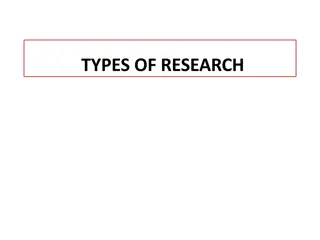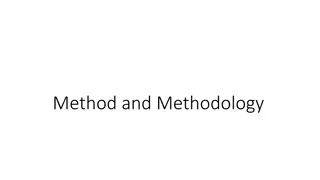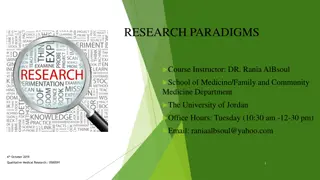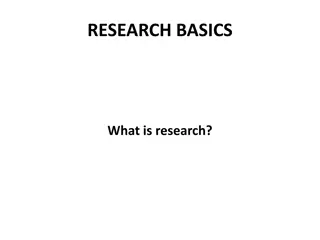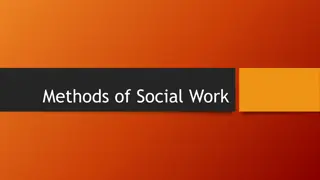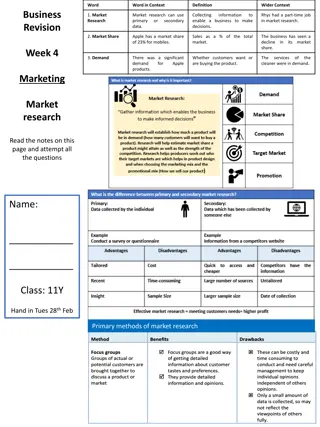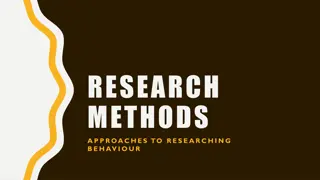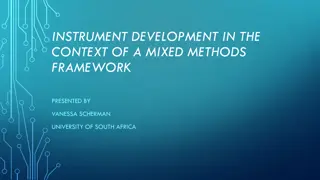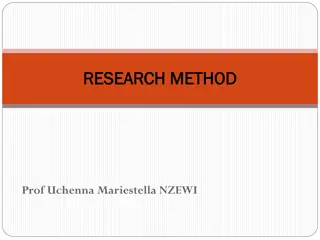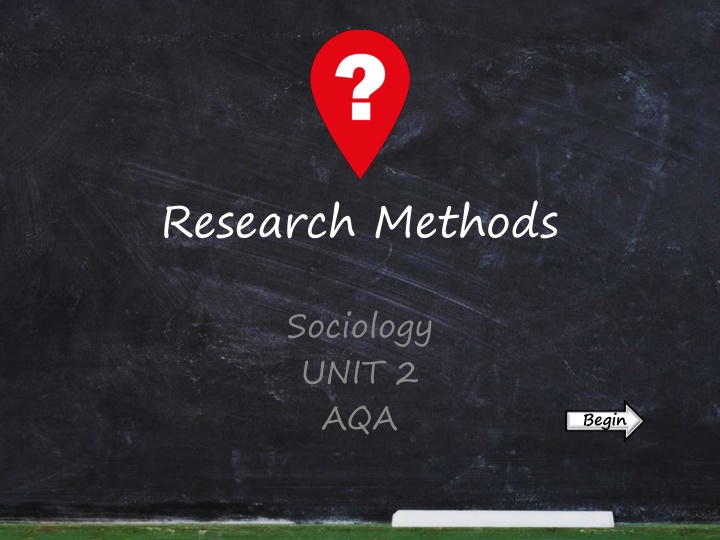
Research Methods in Sociology: Understanding Positivism and Interpretivism
Explore the key concepts of positivism and interpretivism in sociology, focusing on the differences in research methods, reliability, validity, representativeness, methodological preferences, practical factors, and ethical considerations. Understand how societal study is approached from quantitative and qualitative perspectives, examining the significance of data reliability, authenticity, and ethical practices in sociological research.
Download Presentation

Please find below an Image/Link to download the presentation.
The content on the website is provided AS IS for your information and personal use only. It may not be sold, licensed, or shared on other websites without obtaining consent from the author. If you encounter any issues during the download, it is possible that the publisher has removed the file from their server.
You are allowed to download the files provided on this website for personal or commercial use, subject to the condition that they are used lawfully. All files are the property of their respective owners.
The content on the website is provided AS IS for your information and personal use only. It may not be sold, licensed, or shared on other websites without obtaining consent from the author.
E N D
Presentation Transcript
Research Methods Sociology UNIT 2 AQA Begin
Positivism Society is measurable & objective Social forces dictate how we behave Standardised methods of research determine causes of behaviour Look for patterns and trends to Look to obtain Quantative data Make a generalised judgement
Interpretivism Society is subjective, filled with meaning that is given to events by social actors Open-ended valid data is key Qualitative data allows interprevists to understand the meaning of events
Reliability Reliable data, is data which can be obtained repeatedly. Allows a hypothesis to be tested repeatedly by standardised methods As such, positivists treat societal study much like natural scientists
Validity Valid data refers to the authenticity of the data provided as close to reality as possible Structured methods are rejected as they do not reveal how social actors think or feel.
Representativeness Use of a sample in an attempt to create a representation or micro-cosm of society within a study Positivists emphasise this because of their need to be objective and generalise
Methodological preference Interprevists prefer qualitative data. This can be obtained through unstructured methods. Positivists prefer quantitative data. This can be obtained through structured methods. Observations Unstructured interviews Questionnaires
Practical Factors Time Some methods take more time than others Finance Some methods are cheaper than others Personal May have other commitments as well as research Subjects Some societal groups are less open Opportunity If spontaneous, may have little preparation time Danger direct contact with dangerous groups may be harmful to the researcher
Ethical factors Consent Do those involved whish to be researched? Shouldn t be manipulated or misled. Confidentiality right to anonymity. Difficult with smaller groups Research can be used against a person
Lab Experiments Posivists argue that experiments can be used to objectify society Interprevists claim society cannot be translated into experiments Artificial can t simulate society Variables more than one variable to measure and control Ethical often deceived as to the aim of the research Hawthorne effect knowing you are being experimented on may change behaviour Limited application
Field Experiments Experiments, which take place in the social world Less artificial More valid Less control cannot control society Limited few situations this can be applied to Ethical due do a lack of informed consent
Surveys Closed questions options are given to respondents Open questions respondents are free to give their opinion Aims: Most surveys have an aim on what they wish to study Hypotheses: More specific than an aim, it is an explanation that can be tested Operationalising concepts: Making to define sociological concepts so as to be able to measure or observe them effectively and consistently
Sampling Sampling frame: a list of members of a research population For a sample to be representative it must contain a micro-cosm of wider society want to make generalisation Important because positivists
Types of Sample Random: everyone in the sampling frame has an equal chance of being selected Systematic: selecting the nth person in the frame to avoid bias Stratified: constructed in proportion to groups in society based on the breakdown of the frame. Quota: Researcher is given a quota to fill
Questionnaires Positivists prefer as they provide reliable Quantative data They allow a hypothesis to be tested Objective Detached from the respondent Because of large scale they are representative Short limits amount of info Low response rate decrease representativeness Inflexible Right answerism Scientific is key
Structured Interviews A questionnaire delivered and scribed by interviewer Closed questions are used which can be measured and quantified by researchers Reliable Representative due to interviewer effect less than QAs Higher response rate Greater expense Lack of validity Reliability, Cheap Limited interviewer effect Hard to negotiate sensitive issues
Unstructured Interviews More flexible, conversational interview Open questions Qualitative guided by interviewee meaning Guided by both interviewee and interviewer Stronger rapport More likely to open Lack reliability and representativeness Unsuited to sensitive issues Expensive May stray into relevant subject matters
Observations The observer joins in Participant Observation Observations recorded in the field Open mindedness produces best research Used by interprevists to discover actions Validity Open research process Insight into activities allows deep understanding Covert PO may allow access to closed groups Unreliable Not representative small sample Hawthorne effect behaviour may change if aware of observation Going Native
Structured Observations Use of an observation schedule to identify behaviours More measurable and reliable Generalisation possible Easy to compare data Lack validity
Covert and Overt Overt May struggle to protect subjects identities May be denied Questioning subjects Maintaining membership May act differently around researcher Trade-off between factors Covert Ethical Lack of informed consent Access Hard to gain entry Suspicious if too many direct questions are asked Constant risk of blowing cover Group acts normally therefore more valid Openly question Once accepted retention is easy Validity of Data
Statistics HardStatistics Simple counts of events which are not easily manipulated Soft Statistics manipulatable statistics Measurable, Reliable and Representative Available Large scale coverage of social life Prompt for further research Provide a source of background data Comparable Comparative method Definitions can be changed by politicians Social constructs Politically biased Feminists argue a patriarchal bias
Documents Personal Documents Allow us to discover meaning behind actions Written for personal purposes validity Cheap Time saving Some groups are unlikely to produce documents Created with the benefit of hindsight
Documents Public Documents Produced by governments and organisations Likely to be selected and presented with bias Historical documents are one of the only ways we can study the past Can be quantified to discover coverage of an issue Authenticity, Credibility, Representativeness and Meaning should all be assured Scott (1990) Can provide a historical meaning to events
Methods in context (Education) When answering a methods in context question, you must include Practical Ethical Theoretical Perspectives on the method.
My exam technique Short Answer (Each Question) Analyse the question Read & Underline the Source (If mentioned) Answer Essays Analyse the question Plan Answer
Analysing the Question What is the question asking you? What is a beanpole family? - Definition How are women exploited and oppressed in the family? (2 ways) List 3 features of the symmetrical family Mentally rephrase it Questions are from Unit 1 but principle is the same
What do I need to put into the question? Whenever you see a question, decide which sub-topic the question is focusing on. Then recall your knowledge and apply it as required
Read the Source Do not neglect to read the source. However, read quickly underlining as you go.
Essays Read every word before you start to plan. Follow the steps as before.
Plan Visualise a broad overview of your sociological knowledge. What can you use to answer the question. Social Policy in the family needs you to take an overview of the whole of Family and Households. Write your plan paragraphically



